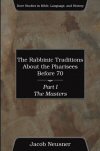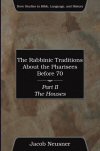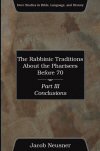The Rabbinic Traditions about the Pharisees Before 70 AD (3 vols.)
Digital Logos Edition
Overview
Several generations of scholars have produced histories of Second Temple Judaism, but none have systematically analyzed the Pharisaic-rabbinic traditions those histories cite. Consequently, scholars often refer to rabbinic traditions about the Pharisees as though everyone knows how the Jews of this period passed on these traditions—and to what extent they are historically reliable.
Prolific scholar Jacob Neusner produces an accurate history of the Pharisaic masters and houses in the Second-Temple period in Palestine. In the first part of this three-volume set, Neusner focuses on the Pharisaic masters. In Part II, he describes the Pharisaic houses, and in Part III, he provides a summary of his ideas.
In the Logos editions, these volumes are enhanced by amazing functionality. Important terms link to dictionaries, encyclopedias, and a wealth of other resources in your digital library. Perform powerful searches to find exactly what you’re looking for. Take the discussion with you using tablet and mobile apps. With Logos Bible Software, the most efficient and comprehensive research tools are in one place, so you get the most out of your study.
For more on the history of the Pharisees in Palestine, check out Pharisees, Scribes, and Sadducees in Palestinian Society.
Looking for more from distinguished Jewish scholar Jacob Neusner? Try the Jacob Neusner Jewish Studies Bundle, 99 volumes on Jewish history, religion, philosophy, and more.

- Provides a comprehensive study of the Pharisaic masters and houses in Palestine before 70 AD
- Gathers a wealth of research using primary sources
- Includes multiple indices for clarification of terms
- Title: The Rabbinic Traditions about the Pharisees Before 70 AD
- Author: Jacob Neusner
- Series: Dove Studies in Bible, Language, and History
- Publisher: Wipf & Stock
- Publication Date: 2005
- Volumes: 3
- Pages: 1,248
- Resource Type: Monographs
- Topic: Judaica
This title is included in the following collections
You can save when you purchase this product as part of a collection.
Jacob Neusner Jewish Studies B...
$1,214.99$1,214.99Logos 8 Messianic Jewish Plati...
$1,499.99$1,499.99Logos 8 Messianic Jewish Diamo...
$2,999.99$2,999.99Wipf and Stock Ultimate Collec...
$11,593.84$8,499.99

In this volume, Jacob Neusner focuses his attention on the traditions of such Pharisaic masters as Simeon the Just, Antigonus of Sokho, Yohanan the High Priest, and others.

Jacob Neusner analyzes the Pharisaic houses of the Second-Temple period in Palestine before 70 C.E. He focuses on the houses of the Tannaitic Midrashim, including Ishmael and Simeon Yohai, as well as the houses of Mishnah-Tosefta and Beraitot, including Zera’im, Mo’ed, Nashim, and others. Neusner also provides collections of houses-disputes in Mishnah-Tosefta.

Having examined the individual pericopae from formal, literary, historical, and redactional-critical perspectives in the first two volumes of this collection, Neusner characterizes the literary and historical traits of the tradition as a whole in Part III. He expounds on the types and forms of tradition of the Pharisees during the Second-Temple period and explains the legal traditions and historical narratives handed down by the Pharisees during this time.